The best recipes for feeding cucumbers with milk and iodine
When growing cucumbers, you cannot do without fertilizing and drugs for the prevention and treatment of diseases. Although there is a large selection of different chemicals on the horticultural markets, gardeners are increasingly abandoning them in favor of folk remedies. One of them is a mixture of milk with iodine, which is suitable for both fertilization and plant treatment.
The content of the article
Purpose of processing cucumbers
Milk and iodine are absolutely harmless, suitable for any stage of the growing season of the crop and allow you to grow organic cucumbers... The composition applied to vegetables does not even have to be washed off, since it is safe for humans and plants.
The mixture is used for:
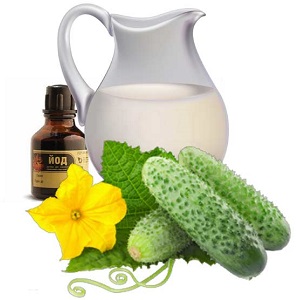 feeding cucumbers;
feeding cucumbers;- strengthening immunity;
- increasing the duration of fruiting;
- lash rejuvenation;
- disease prevention;
- pest and infection control.
Some gardeners use whey instead of milk.... The effectiveness of the product does not decrease.
Act
Treatment of plants with preparations with dairy and iodine components performs several functions... To understand how effective such a tool is, consider the principle of its action in each case.
Fertilizer
Feeding with iodine and milk saturates cucumbers with microelements, strengthens their immunity... Iodine increases the metabolism of plants, stimulates the development of bushes and ovaries, improves the taste of vegetables.
Milk in such a top dressing is the main nutritional component containing:
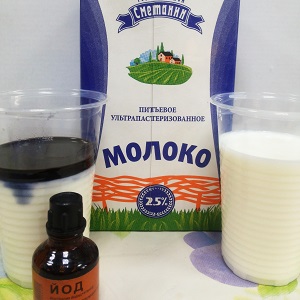 calcium;
calcium;- magnesium;
- iron;
- copper;
- manganese;
- phosphorus;
- nitrogen;
- potassium.
Especially valuable for cucumbers phosphorus (responsible for the development of the root system), potassium (promotes fruit setting), nitrogen (important for the formation of greenery).
Important! Whole milk contains a large amount of fat, which is harmful to plants. Therefore, it is diluted with water.
Pest control
The agent scares away aphids, whitefly, spider mites, slugs. Milk contains lactose, which insects cannot digest, and iodine causes poisoning in some of them. Cucumbers sprayed with such a composition become inedible for pests, therefore, the product is also used as a prophylaxis.
Treatment and prevention of diseases
Milk spraying with iodine is effective for the prevention of diseases in the early stages of development... If a significant part of the bushes is affected, then it will not be possible to do without chemicals.
In this case, iodine in the composition of the drug plays a major role. He has such actions:
- antifungal;
- antimicrobial;
- immunostimulating.
The substance not only destroys infections, but also enhances plant resistance to diseases and negative environmental factors. It is used both separately from milk and together with it.
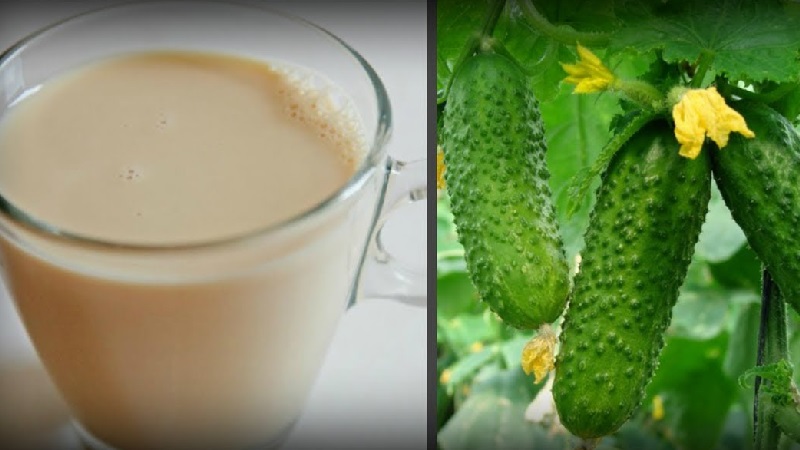
Milk enhances the effectiveness of the product, protects against re-infection... The acids in its composition have a detrimental effect on fungi and bacteria, lactose and lipids form a protective film on the surface of the leaves, preventing the infection from entering.
Important! Milk and iodine are effective only against fungal and bacterial diseases. They will not cope with viral infections.
Recipes
The concentration of the components depends on the purpose of the application... For spraying, the concentration is increased, for irrigation, it is reduced.
To fight diseases and pests, a more concentrated composition is used.than for dressing, otherwise the drug simply will not have a disinfecting effect.
Important! They take raw milk: when boiled, the product loses most of its nutrients.
For fertilization
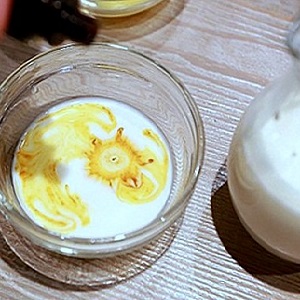 Cucumbers fed by the root or by spraying the leaves.
Cucumbers fed by the root or by spraying the leaves.
For the first time, the product is used 2 weeks after the formation of 2 true sheets... Iodine feeding strengthens plant immunity, stimulates the formation of the root system.
When grown outdoors the product is applied at the root 1-2 times per season. The rest of the time, other formulations are used.
Foliar fertilizers are used 2 more times... At the flowering stage, boric acid is added to the mixture, which accelerates the formation of ovaries. The second time they spray the bushes during fruiting.
Cucumber dressing recipes:
- Yeast: add 2 tbsp to 1 liter of milk. l. yeast and 1 tbsp. l. sugar, leave to ferment for 3 hours. After pouring in 1 liter of milk and 10 drops of iodine. Dilute everything in 8 liters of water at room temperature. 1 liter is poured onto the bush under the root.
- With ammonia: 2 liters of milk are poured into a bucket of 10 liters, 1 tbsp. l. ammonia, 10 drops of iodine. The rest of the volume is filled with water. The drug is sprayed on cucumbers during flowering and ovary formation.
- With urea: for 8 liters of water, take 2 liters of milk, 8 drops of iodine, 50 g of carbamide. Cucumbers are watered with the product no more than 1 time per season, spending 0.5 liters per plant.
- Regular: 1 liter of milk is diluted in 6 liters of water, 6 drops of iodine are added. The product is well suited for fertilizing seedlings.
To fight disease
Such formulations easily deal with infections, which have already hit the bush, but did not have time to penetrate the plant cells.
Prevention is carried out during epidemics once a week... Antifungal treatments are required during cold snaps and after prolonged precipitation, when pathogens are most active.
If the plants are already sick, then at an early stage of the development of the infection they are sprayed with such a mixture 2 times a week until the problem is stopped. The damaged parts of the bushes are completely removed.
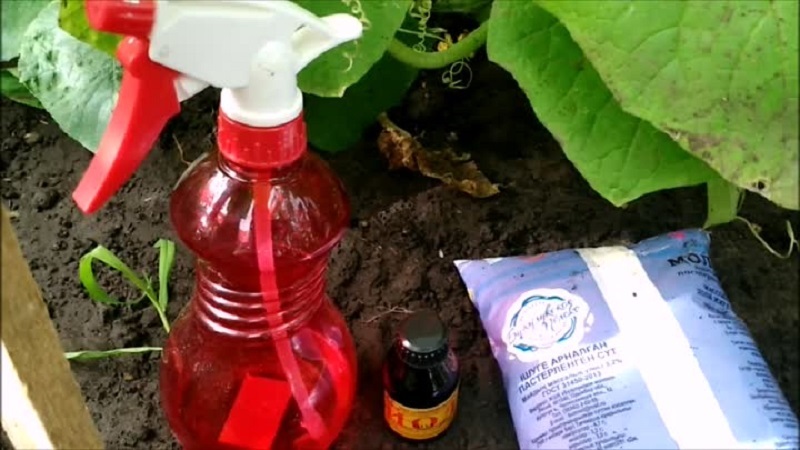
How to treat cucumbers with milk and iodine for diseases:
- With sour milk: 3 l of product is mixed with 7 l of water and 20 drops of iodine. The ingredients are thoroughly mixed and used for preventive spraying of plants.
- With soap: For 10 liters of water, take 2 liters of milk, 30 drops of iodine and 0.5 bar of laundry soap. All components are thoroughly mixed until the soap is completely dissolved.
- With hydrogen peroxide: 2 liters of fresh or sour milk, 40 drops of iodine, 1 tbsp. l. hydrogen peroxide is poured into a 10 l bucket. The rest of the volume is filled with water. All ingredients are mixed.
These funds used for spraying bushes or watering with root rot. In the latter case, a ditch is dug at a distance of 5 cm from the garden bed, where the solution is poured.
For pest control
Insect Control Recipes:
- With ash and soap: add 1 piece of grated laundry soap to a 10 liter bucket of water, 2 tbsp. ash, 30 drops of iodine, 2 liters of milk. The soap is applied so that the rest of the ingredients stick well to the bush.
- With urea: 1 liter of yoghurt or whey, 20 drops of iodine, 15 ml of urea are poured into a 10 liter bucket of water.
Such preparations are used for spraying, not for watering.
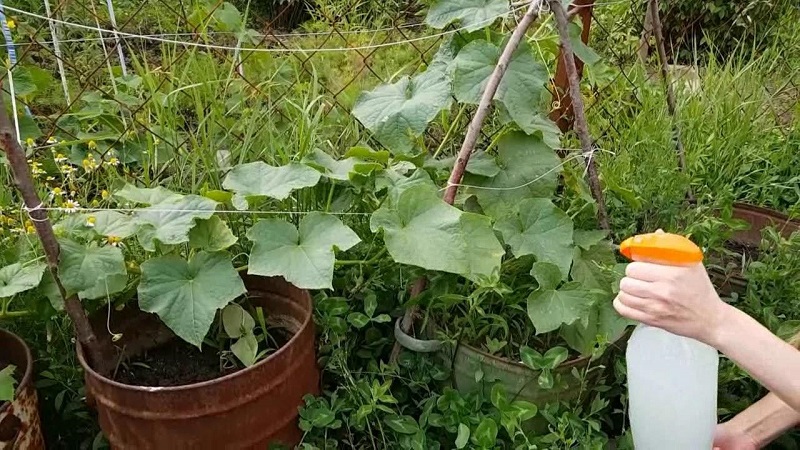
Processing rules
For substances to be beneficial, it is important to use them correctly. Basic Tips:
- Top dressing is applied under the root only after thorough moistening the day before, so that there are no burns on the roots.
- Watering cucumbers with a remedy early in the morning or at sunset: wet leaves increase the risk of burns.
- Spray the culture after 5 true leaves appear. If you do this earlier, the plants may die. An exception is a pure milk solution with a small amount of iodine.
- Plants begin to spray from the lower leaves, consuming more of the preparation here and gradually rising upward.
- Iodine top dressing is not mixed with other ready-made fertilizers and means for combating diseases and pests.
- The solution is used immediately after preparation, otherwise some of the nutrients will evaporate and the product will lose its beneficial properties.
Features of processing in the greenhouse and open field
The processing methods in the greenhouse and in the open field are generally the same, but there are still a few nuances:
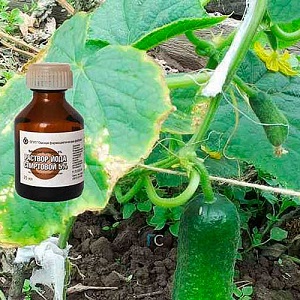 The first 2 hours after treatment, the milk and iodine product is washed off with water. Once dry, regardless of the weather, the bushes remain protected for a week. Therefore, plantings in the open field are sprayed at least 2 hours before rain or watering.
The first 2 hours after treatment, the milk and iodine product is washed off with water. Once dry, regardless of the weather, the bushes remain protected for a week. Therefore, plantings in the open field are sprayed at least 2 hours before rain or watering.- There is no threat of sudden precipitation in the greenhouse, but the air exchange there is weaker than in the open field. Therefore, the product is used indoors less often, once every 2 weeks.
- Not only the plants themselves are treated for diseases, but also the soil around them. The product is suitable for disinfecting greenhouse walls and floors.
If you hang open bottles of iodine in a greenhousethen the cucumbers will not hit late blight.
Precautions
The mixture, if used improperly, will harm both plants and the gardener. To prevent this from happening implement a number of recommendations:
- Maintaining proportions... When preparing, the products do not deviate from the recipe. Increasing the amount of milk or iodine will kill the plants. Not enough ingredients will make the solution ineffective.
- Gardener protection... The treatment is carried out in a protective tissue mask: a large amount of iodine negatively affects the state of the thyroid gland.
- Preliminary verification of funds... First, 1 bush is sprayed with a new composition. If after 2 days there are no signs of deterioration in his condition, the drug is used on the remaining plants.
- Processing frequency... Preventive spraying for diseases is carried out no more than 1 time a week. At the root, milk-iodine dressings are applied no more than 2 times per season.
Conclusion
Formulations with iodine and milk are effective folk remedies for processing cucumbers and other plants. They are absolutely harmless to the environment, stimulate the development of bushes and the formation of ovaries, increase yields, protect plants from pests and diseases... Substances can only harm plants if used improperly.